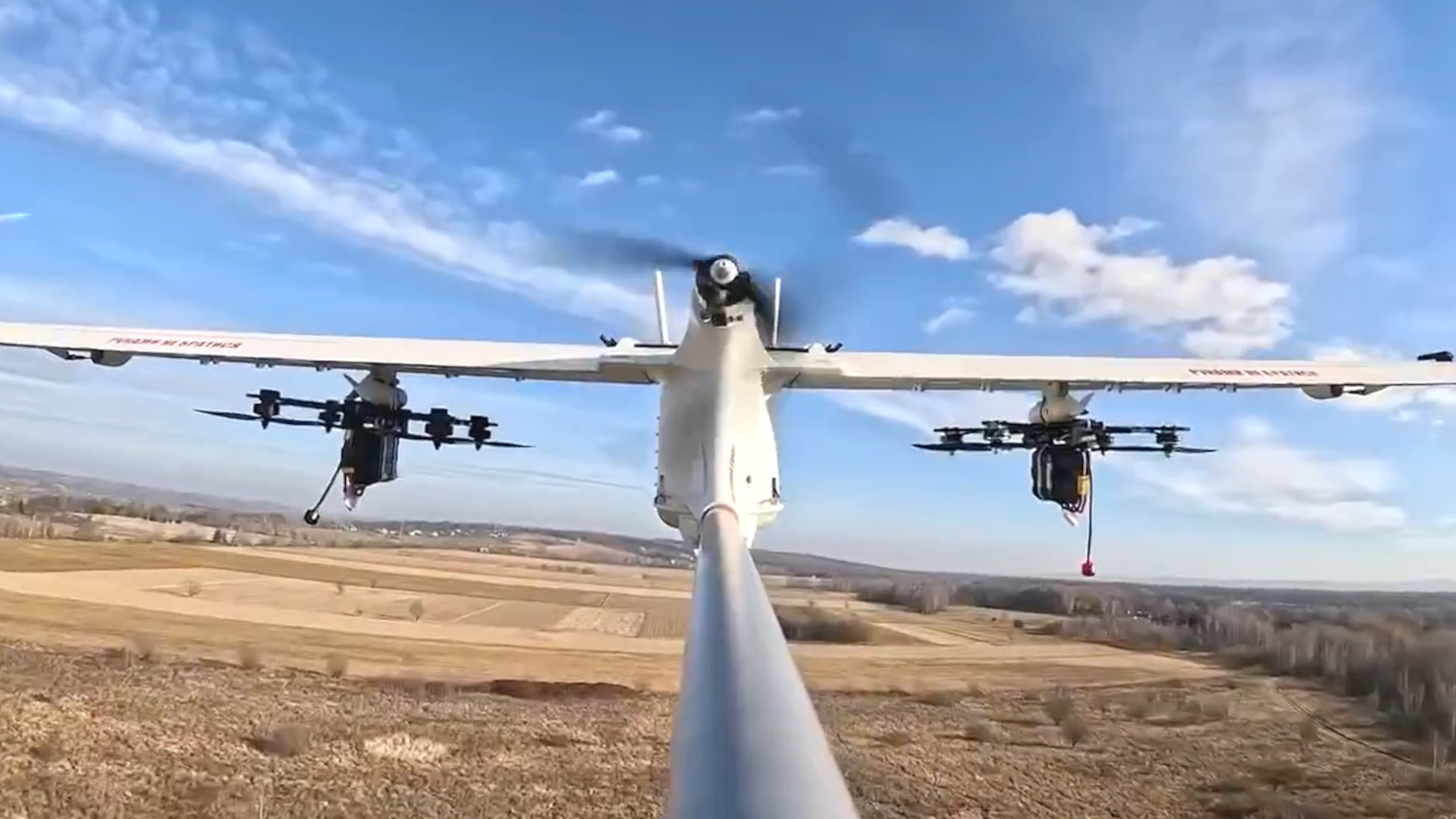Ukraine’s domestically developed Dovbush T10 drone has taken on a new role acting as a mothership for first-person view (FPV) kamikaze quadcopters. In this configuration, the T10 also serves as a key signal relay node between the highly maneuverable one-way-attackers and their operators.
Serhii Beskrestnov recently posted video, seen below, of an apparent test of a mothership T10 carrying two FPV kamikaze drones, one under each wing, on his Telegram channel. Beskrestnov (sometimes referred to by the pseudonyms Serhii Flash or Flesh; his first name can also be found written as Serhiy) is a Ukrainian servicemember who has been cited as an expert in “radio technologies” and other military electronics. He regularly posts about new uncrewed aerial systems, electronic warfare, and other battlefield developments.
According to Beskrestnov, the T10 mothership can carry up to six FPVs at a time. The footage he shared online shows picture-in-picture views as the kamikaze drones are released while their launch platform continues on separately. A single pickup truck looks to be the test target for both kamikaze drones.

Interestingly, the clips also show that the drones are held in place upside down under the T10’s wings via their small bomb-shaped payloads and that they flip over when they are released.
In his Telegram post, Beskrestnov did not provide more details about the T10 mothership’s capabilities, including its range and endurance and how far the FPVs can reach after launch.
The T10 first emerged in late 2022 configured as a surveillance and reconnaissance platform with an unspecified sensor package and a reported range of just under 22 miles (35 kilometers). The drone can also be employed as a one-way-attacker with a nearly 26-and-a-half-pound (12-kilogram) warhead. In its baseline configuration, the design reportedly costs around $12,000.
The T10’s primary mode of launch appears to be via a rack installed on the top of a pickup truck, which gets it up to a suitable speed to fly off on its own. How it might be recovered after a mission is unclear. The design reportedly features a navigation package that can fall back in some way on inertial navigation system (INS) guidance if its GPS signal is jammed, something that is a major threat on the battlefield in Ukraine.

At its most basic level, the T10 mothership offers a way to maximize the reach of typically short-range FPV drones by releasing them at the edge of its own combat radius. The FPVs also gain extra loiter time, which they could spend on identifying and/or maneuvering to their targets, or even waving off an initial attack run and coming back from a different, unexpected vector.
Putting the signal relay on the mothership orbiting above also puts that node closer to where the FPVs are actually operating, making it easier to maintain connectivity. The graphic below offers a good visual depiction of the overall benefits of this combination.

The T10 mothership is not the first such combination to emerge on the battlefield in Ukraine, with the Russians also employing larger drones as aerial launch platforms and signal relay nodes for FPVs.
The U.S. military and others have also been exploring similar ‘nested’ uncrewed aerial capabilities outside of the conflict in Ukraine.
The introduction of artificial intelligence (AI) driven capabilities into the equation, something that is already happening in Ukraine, may offer a new and especially significant step forward for FPV kamikaze drones, in general. AI-enabled targeting capabilities would be a huge boon for FPVs, especially in the terminal phase of flight, where human operators currently have to manually find targets and steer the drone into them. You can read more about the game-changing impacts AI is set to have on drone operations in this War Zone feature. However, blending launch platform and signal relay in a single mothership package already helps address many of the limitations. AI targeting could still help in the event that the relay is disrupted or the mothership is shot down.
While Ukraine’s T10-based drone mothership may not be the first such design to emerge in the conflict there, it is more evidence of the value this kind of combination offers already.
Contact the author: joe@twz.com
